A unique feeling envelops you when you voyage across Oneida Lake's surface, a sensation of immersion within a pulsating biosphere that teems with life.
Odors of algae, vegetation, and fish mix together, saturating the air with a rich blending.
Midges and related aquatic insects rise from the lake's depths and clouds of them hover above you while their body casings, discarded in the hatching process, punctuate the surface of the water below.
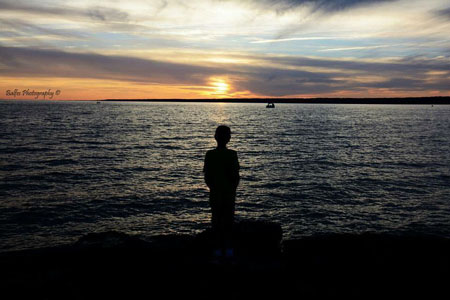
As your voyage unfolds, baitfish such as emerald shiners and young yellow perch often congregate alongside your boat, vast schools following the vessel as if you were Saint Patrick of the waves. Millions of immature white bass and white perch, newly grown from spring's successful spawning, their glistening sides reflecting sunlight like a mirror ball, cruise just beneath you, gorging on Daphnia and other zooplankton.
Walleyes and smallmouth bass prowl below these tiny fish, inciting a terror that makes thousands break water in unison, vainly attempting to escape fate. Gulls and terns prey upon the panicked bait and the air resounds from the birds' haunting cries.
Traveling into the lake's shallower realms, you view the bottom through water clarified by millions of zebra mussels. These tiny mollusks filter out algae and attach to rocks, shells, and any hard surface. You reach overboard and pick a stone from the lake and hidden life gushes forth as amphipods, midge larvae and other invertebrates emerge from the zebra-encrusted mass. Throughout these inshore waters you are amazed by the abundant, dense weed beds, aquatic nurseries for many of the lake's creatures. Schools of juvenile fish scurry amidst the vegetation, feeding upon the omnipresent invertebrate life and avoiding, whenever possible, the northern pike and largemouth bass that thrive there.

Photo by Susan Campbell
This Oneida Lake living mosaic has prodded imaginations and inspired poetry and prose. In 1874, a writer from the utopian socialist Oneida Community vacationed at the Community's "Joppa" retreat cottage at Sylvan Beach. Envisioning Oneida's rich food web, he penned these words:
How these waters must swarm with life! Suppose the lake be drawn off and its bed laid bare. What a writhing, squirming, flopping, gasping mass would be disclosed! Great eels and water snakes, huge muskellunge and catfish enormous snapping turtles, the fierce pike and belligerent bass, ugly lizards, and acres on acres of bullheads, lawyers, whitefish and perch. In short, the whole vast population of the great lake basin would appear, a sight to ravish the epicure, delight the zoologist, and fill with crazy acquisitiveness the man of dollars and cents.
Contemporary Oneida Lake is undergoing great biological changes. Fluctuating fish populations, the invasion of zebra mussels, and a drop in the lake's phosphorus levels have brought about these alterations.
Zebra mussels entered the Great Lakes' waterways' system in ballast water discharged by European freighters during the late 1980's. Upgraded and expanded sewage treatment facilities and laws regulating detergent ingredients caused the phosphorus decline. Today, the lake remains in a state of metamorphosis.
Scientists at Cornell and Syracuse Universities have chronicled the lake's ecological history since the early 1900's and their research has amassed a tremendous reservoir of knowledge and understanding. This pamphlet, the Oneida Lake Profile, reflects these findings and contains a general synopsis of the lake's ecology and history. The Profile, prepared by the Cornell University Biological Field Station, at Shackelton Point, and by the Oneida Lake Association, is designed to promote an environmental literacy that will abet the preservation of one of New York State's finest inland waters.
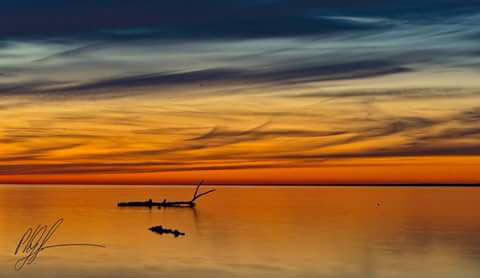
Photo by Phil Johnson
The Geologic Background
Oneida Lake is a remnant of Lake Iroquois, a huge body of water that formed nearly 12,000 years ago when, as the Ice Age ended, a glacier dammed the St. Lawrence River, flooding much of Central New York.
As global warming occurred and the ice mass shifted northward, the St. Lawrence outlet to the Atlantic Ocean opened and Lake Iroquois' waters drained. Oneida Lake was created when water remained in a slightly deeper depression in the former Lake Iroquois bed.
Evidence of the Oneida Lake region's glacial origins is visible today. Hills south of the lake, near Canastota, are underlain by rock that was resistant to erosion and, consequently, the glacier lifted over this escarpment and left deposits of shale and limestone in its path. Swamps near Cicero and Canastota, containing extensive muck and peat deposits, were a part of the original glacially-created Lake Iroquois depression, but eventually separated from Oneida Lake.
North of the lake, glaciation of the Tug Hill upland left a thin layer of debris over the resistant sandstone bedrock. Large boulders, dropped by the glacier in fields surrounding Oneida Lake, bear further witness to the ice age's effects. Satellite View.
A Brief History
Prior to European exploration, Native Americans utilized Oneida Lake's fishery. Artifacts that document their occupation have been discovered at Brewerton, Shackelton Point, and other sites by the lake. Later, the Oneidas and Onondagas, members of the powerful Iroquois Confederacy, settled in the region.
The Oneidas, who called the lake Tsioqui (meaning "white water" -- a reference to impressive wave action), constructed fishing villages near Oneida Creek's mouth and along Fish Creek, near Sylvan Beach.
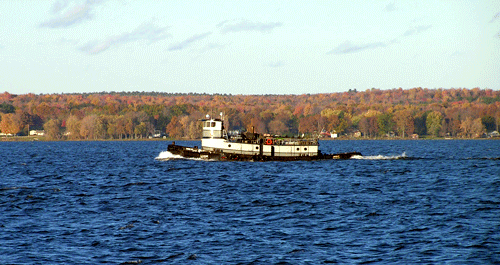
Their annual Atlantic salmon harvest yielded tons of a once common Oneida Lake fish and was vital to their sustenance. The Onondagas also valued the lake's fishery and, from camps at the Oneida River outlet and near Chittenango Creek's mouth, they netted eels, salmon, catfish, pike and related bounty. Archaeologists have uncovered many Iroquois artifacts at various locations near Oneida Lake.
Lands surrounding Oneida Lake were opened for white settlement in the late 18th century. The Scriba Patent, a land company founded by George Scriba in the 1790's, marketed a significant acreage that stretched from Oneida's north shore to Lake Ontario. The Military Tract, an area of government land that bordered the lake's western end, was reserved for veterans of the American Revolution. Parcels not given to former patriots were eventually sold to the general public. The Oneida Lake region was sparsely settled until the early 1800's, when the "Yankee Invasion" of Upstate New York sparked the area's first major development. During this era, which lasted through the 1820's, thousands of New Englanders left their marginal farms, seeking better land. The Oneida Lake locale, in particular its fertile south shore, attracted many of these people.
The Erie Canal, built from 1817 to 1825, bypassed Oneida Lake. However, the lake was linked to the Erie by the Oneida River and through two "Oneida Lake Canals." The first of these, sometimes called the "Side Cut Canal," was built in the 1830's and connected the Erie Canal with Fish Creek, at a point about a mile east of the lake. Logging, centered in Oneida's north shore communities, and the sand business, based along the lake's east end, made this waterway a modestly successful enterprise. The second Oneida Lake canal, constructed in the 1870's during the heyday of New York State railroading, proved to be a dismal economic failure.
The Erie-Barge Canal, an enlargement of the old Erie that was completed around 1916, used Oneida Lake as a part of its course and the lake became a cog in the state's water transportation network. Hundreds of tugs and barges used the lake during the Erie-Barge's peak years, and Brewerton and Sylvan Beach became active canal ports.
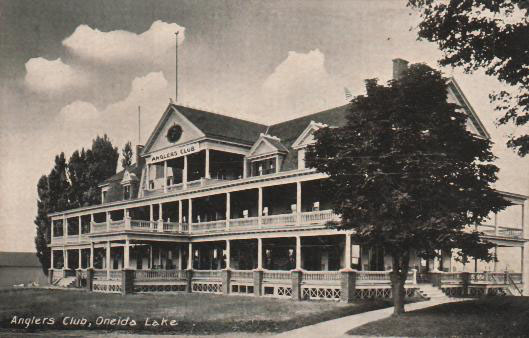
Lakeside communities grew at different times. Constantia's and Brewerton's earliest settlers arrived in the 1790's. Bridgeport's genesis occurred around 1802 and Lakeport's by 1811. These communities served as commercial centers for the surrounding farm population and as summer resorts.
North Bay was popular with sportsmen in the 1850's, while Sylvan Beach's initial growth occurred in the 1870's. The 1880's and 1890's witnessed Sylvan and Verona Beaches' transformation into the "Coney Island of Central New York." Scores of hotels, thousands of vacationers, two amusement parks, and even a boardwalk highlighted summers at "the Beach" during this era.
The glass industry contributed to Cleveland's and Bernhard's Bay's 19th century economies, while Jewell and West Monroe benefitted by being station stops on the Oswego-Midland Railroad (later renamed the Ontario and Western).
A trolley line brought Syracuse tourists to Lower South Bay, where grand steamboats like the Sagamore and the Manhattan awaited. Cottage and camp construction altered the lake's shoreline in the latter 1800's and early 1900's and accelerated as post-World War I prosperity and the "Golden 20's" embraced the United States.
Although slowed by the Great Depression, the development of Oneida Lake's periphery proceeded throughout the 20th century to the point where, by the 1990's, few parcels of wild lake shore remained. Productive, lake-nourishing wetlands still thrive in the vicinity of Toad Harbor, Cicero Swamp, and Verona Beach State Park. Widely scattered woodlands lend their greens to the north shore vista and the last remaining lake-bordering crop field, a lush hay meadow west of Lakeport, may soon experience a builder's makeover. The completion of Interstate 81, in the 1960's, transformed the distance from Oneida Lake to Syracuse into an easy commute. As a result, Cicero, Brewerton and the surrounding countryside suburbanized. An influx of Federal Government and New York State funding for Erie-Barge Canal recreation enhancement, coupled with major land acquisitions by the Oneida Indian Nation, may dramatically alter the Sylvan-Verona Beach area. The Oneida Lake scene of the impending millennium will likely exhibit vivid contrasts with memories of the 20th century.
Biological Changes in the Lake
Oneida has undergone significant biological changes over the past two decades. A major contributor to these alterations is the recent invasion by the zebra mussel, a small (less than two inches long) bivalve mollusk, with an elongated shell, usually marked by alternating light and dark bands. Zebra mussels are native to the Black, Caspian, and Aral Sea basins of Eastern Europe and Western Asia and are believed to have entered North America's Great Lakes in freshwater ballast dumped by ships that originated in European ports. Zebra mussels siphon up to one quart of lake water per day into their shell. Their gill system filters out microscopic algae and bits of organic debris.
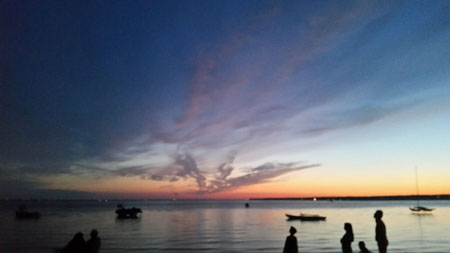
Photo by Maureen Dunn Campbell
Oneida Lake, with its well-mixed waters (produced through a combination of shallow depths and powerful wind action), warm summer temperatures, and high levels of calcium required for shell formation, provides an ideal zebra mussel habitat.
Mussel densities in some lake bottom areas exceed 100,000 per square meter. Numbers of zebra mussel larvae, called veligers, peaked in 1995 and, in 1997, their concentrations were the lowest recorded since 1992.
In the past, algae blooms frequently clouded Oneida Lake's waters, but now the lake often displays striking crystalline qualities. The depth of light penetration, as measured with a black and white disc (what scientists call a "Secchi Disc"), increased in the 1990's to an all time record 30 feet. Anglers have learned that walleyes, which avoid strong light, have abandoned shallower, exposed reefs and, instead, seek shelter in weed beds and in deeper water, where light intensity diminishes.
Zebra mussel-induced clarity allows light to penetrate deeper and stimulate plant growth. Beds of submerged plants, that once grew in limited areas near shore (in about three to six feet of water) now thrive in depths up to twelve feet. Rooted aquatic plants hinder boating, but provide escape cover for small fish and are the preferred habitats for largemouth bass and sunfish. While shallow water species appear to be thriving, the long-term effects of weed bed expansion on walleyes, yellow perch, and other species that live primarily in the lake's deeper areas are yet to be seen.
Although filtering by zebra mussels has diverted some of the lake's production to the bottom, the normal algae-zooplankton-fish food chain linkages have not been seriously affected. With light penetrating deeper, more of Oneida's water column can produce algae. This may explain why zooplankton populations have not declined. With adequate zooplankton as a food base, the lake's fish production should remain high. Zebra mussels' fecal waste material is deposited on the lake's bottom and is fed upon by invertebrates such as amphipods and midge larvae. Both of these bottom-dwelling organisms use zebra mussel beds for shelter. Consequently, populations of these creatures have thrived, providing an enhanced food source for fish.
On the negative side, zebra mussels' feeding has brought on the extinction of native Oneida Lake clams, important bivalves that cannot successfully compete with the zebras. Clearly, the interacting biological changes caused by the mussels have created a very dynamic Oneida Lake environment and this phenomenon's effect on the "fish community" (all the fish in the lake) will not be known for some time.
The Lake and its Watershed
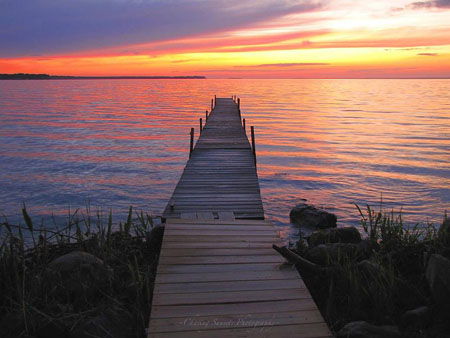
Photo by Kate Chick Anyon
Water from over 800,000 acres in five counties flows into Oneida Lake. We call this area the lake's "watershed." The drainage basin north of the lake (encompassing much of the Tug Hill Plateau region) contributes 67% of Oneida's water, but only 20% of the nutrients needed to sustain the algae and plants at the base of the Oneida food web. The bulk of this water comes from Fish and Scriba Creeks during spring's snow melt period. Canaseraga, Chittenango, and Oneida Creeks, all south shore tributaries that flow through rich farm country and wetlands, carry most of the lake's nutrients.
Throughout history, Oneida Lake has exhibited summer algae blooms that are characteristic of enriched water productivity. French voyagers called Oneida "le lac vert" (the green lake) and colonial travelers refused to drink the "diatom-saturated water" for fear of contracting "lake fever."
Throughout history, Oneida Lake has exhibited summer algae blooms that are characteristic of enriched water productivity. French voyagers called Oneida "le lac vert" (the green lake) and colonial travelers refused to drink the "diatom-saturated water" for fear of contracting "lake fever."
Multi-colored algal swirls across Oneida's surface often resembled an abstract painting and the pungent odors emanating from decaying algae alarmed people. The situation demanded urgent action. Property owners, anglers, scientists and other stakeholders in the watershed made a reduction of the lake's phosphorus levels a priority.
Scientists attached more importance to phosphorus than to nitrogen since phosphorus has a greater effect on algae and plant growth.
Early efforts to reduce phosphorus quantities in Oneida Lake began in the 1970's and were linked to a water quality agreement between the United States and Canada that set target levels for phosphorus entering the Great Lakes. Since Oneida's watershed was a part of the Great Lakes' basin, government funding for upgrading existing sewer districts and constructing new ones became available. In addition, proper management practices were encouraged on agricultural lands. New York State banned phosphorus in 1973 and, by the mid-1980's, Oneida Lake's total phosphorus concentrations were slashed by 50%. This was a major change in the lake's ecosystem.
The Watershed's Wetlands
The diverse and abundant wetlands distributed around Oneida Lake are an integral component of the lake and its watershed. Wetlands like the Cicero and Toad Harbor Swamps provide habitats that are critical for fish and waterfowl survival and also serve as groundwater renewal areas. They retain fertilizing chemicals from watershed runoff, thereby improving Oneida's water quality. Moreover, they serve as "storage tanks" during periods of excessive precipitation, minimizing potential flooding. If remaining wetland areas are destroyed, the lake's environment will suffer.
Protecting wetlands from commercial and residential development should be a long-term management goal for the Oneida Lake watershed. Wetland losses during the past several decades have reduced the watershed's water storage potential, thereby leaving the lake's environs more vulnerable to high water damage.
Over the past decade, the purple loosestrife plant has proliferated throughout Oneida's wetlands. This non-native, purple-flowered plant thrives in marshes and ditches, outcompeting indigenous cattails and related flora, and makes wetlands less suitable for wildlife habitat.
A Portrait of the Fishery
Oneida Lake's present fish community bears little resemblance to its original species population. The first settlers seined Atlantic salmon as the fish entered their native spawning streams. Many of these large fish were shipped to the New York City market and a thriving commercial fishery developed. Ciscos (called "whitefish") were once common in the lake and many eels were trapped as they migrated from the lake to their Atlantic Ocean spawning grounds. Smoked eel was a popular delicacy. In the latter 19th century, Oneida's market fishermen continued to net large quantities of fish and many farmers supplemented their income through this trade.
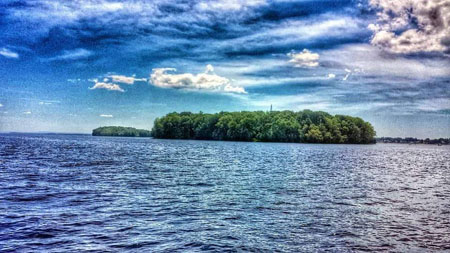
Photo by Gary Johnson
When the New York State Legislature passed laws that limited netting, illegal harvesting proliferated and some legendary characters, called the Oneida Lake "fish pirates," emerged. Tales of these poachers' exploits, especially about their conflicts with game wardens, adorn the lake's history.
Surveys from the 1920's suggest that chain pickerel and walleyes were equally abundant, with northern pike ranking close behind. These fish, and bass, were heavily pursued by fishermen. By the 1940's, walleyes were far more numerous than pickerel and northerns, and the eels and ciscos had become rare.
American societal and cultural changes contributed to the increase in Oneida's walleye population. Other fish species in the lake have had contrasting histories. Atlantic salmon were doomed to an early extinction by lumbering and farming practices, which degraded spawning streams. Dams, constructed to power ancient water wheels, accelerated the salmons' demise. The Barge Canal, with its systems of locks and dams upstream from Lake Ontario, blocked the eels' spawning migration and this population dwindled.
The fates of pickerel and northern pike were closely tied to conditions in the marshes and lake shallows, where both species reproduced. As wetlands were drained for agriculture, and filled for camp and cottage development, pickerel and pike numbers declined. The spawning areas of walleyes were largely unaltered and, as the number of their competing predator fish plummeted, their population prospered.
Since the 1940's, walleyes and yellow perch have dominated the Oneida food web. In addition, changes in the abundance of other fishes have occurred. White perch, an Atlantic Ocean species native to the Hudson River, entered Oneida Lake through the Erie-Barge Canal in the 1950's and, in subsequent years, they occasionally outnumbered yellow perch. Gizzard shad, long present in Lake Ontario and the Oswego River, were seldom observed in Oneida until 1984.
Vast numbers of juvenile shad replaced young yellow perch as the primary walleye food during late summer and early fall in the late 1980's and early 1990's. Few gizzard shad survived through winters, however, and their population fell so that, by 1994, they were again scarce.
The freshwater drum (also known as sheepshead) is another species that has gained prominence. A single successful drum hatch, in 1987, elevated these predators from a minor to a major component of the fish community. By 1995, Oneida's drum numbers equaled about half of its walleye population. Because drum can live for over fifty years, they are likely to remain abundant even without future reproductive success.
Further changes in Oneida Lake's fish community are anticipated. Gobies and Eurasian ruffe, both small but highly prolific European fish, are well established in the Great Lakes and will likely use the Canal System to enter Oneida within the next decade. Biological changes at the base of the lake's food web, caused by the zebra mussels and the decline in algae-nurturing phosphorus, will affect fish populations. Continuous monitoring and research are requisite to understand how new fish species' introductions and food web changes will impact Oneida Lake's walleyes and yellow perch.
Walleyed Pike
The population of adult walleyes has ranged from 200,000 to one million during the past three decades. Anglers have harvested as few as 50,000 and as many as 450,000 in a year.
Cornell University's tagged fish studies reveal that Oneida's anglers' annual harvest usually totals about 25% of the spring walleye population. Another 5% of adults die from other causes. When bait fish are scarce, walleyes are hungry and anglers catch a lot of fish. The reverse is true when forage fish are abundant. Most harvested walleyes are four to seven years old, but those that are able to avoid anglers' lures may live for 20 years or more.
Prey abundance also affects whether walleyes survive to adulthood. In years when Oneida Lake produces high bait fish numbers, young walleyes grow rapidly and fewer are consumed by their older cousins. The lake's walleye population expanded in the 1980's, when gizzard shad and other bait fish abounded. During the 1990's, however, the disappearance of shad, coupled with declines in other prey fish, intensified cannibalism and fewer young walleyes reached maturity.
The goal of walleye management in Oneida Lake is to optimize recreational fishing opportunities, while minimizing the risk of a walleye population collapse and the adverse effects this would have on yellow perch. To control walleye harvests, the Department of Environmental Conservation (commonly called the "DEC") raises minimum size limits to reduce catches when populations are down and lowers length restrictions when walleyes are abundant. The DEC also operates the Oneida Fish Cultural Station, a modern hatchery at Constantia. Eggs from walleyes netted in April are incubated there and about 100 million of the 200 million fry (tiny walleyes) raised each year are stocked in Oneida Lake. Although Oneida's walleyes deposit over 10 billion eggs annually, few survive. About two-thirds of the walleye fry in the lake in May are from the hatchery.
Yellow Perch
Oneida Lake's yellow perch spawn between 40 and 60 billion eggs each spring. Depending on weather conditions during the incubation period, from 2 to 18% of the eggs will hatch and the larvae will survive to become fry.
When perch grow beyond this stage, they risk predation by walleyes and by a host of other fish. The chances of young yellow perch surviving annual environmental conditions and reaching adulthood ranges from 1 in 1,000 to 1 in 30,000.
Records indicate that the number of adult perch available to Oneida's anglers has fluctuated between one and four million.
This population dipped to an all-time low in 1995, but is currently rebounding to levels that are consistent with the long-term average. A third or more of adult yellow perch die each year, with losses attributed about equally to angling and natural causes. By age six, yellow perch weigh nearly a pound. These "jack perch," prized by fishermen, are short-lived when compared to walleyes and few survive beyond age eight. Currently, anglers are limited to taking 50 yellow perch per day.
Some Other Oneida Lake Fish
Oneida Lake supports a diverse fish community, but only a few of the 74 species identified contribute to anglers' annual harvest. Smallmouth and largemouth bass are popular game fish, while rock bass, pumpkinseed sunfish, bluegills, and black crappie (locally called "calico" or"strawberry bass") are sought-after panfish.
Springtime anglers avidly pursue brown bullheads, white suckers, and channel catfish in the lake's shallows. Drum are accidentally caught during many Oneida outings and burbot (commonly called "lawyers") typically bite during winter. In recent years, northern pike have experienced a minor population resurgence and specimens weighing over 10 pounds have been landed.
Lake sturgeon are native to Oneida and their presence has always created headlines. Commercial fishermen netted a 104 pound sturgeon in the Oneida River at Brewerton in 1856. The Syracuse Standard paper made note of the 6 feet 11 inches long fish and the sturgeon was exhibited at the Brewerton House, no doubt increasing that hotel's business. As recently as 1973, the Syracuse Post-Standard reported that a walleye fisherman, trolling the lake's channel north of Frenchman's Island, boated a sturgeon whose weight was estimated at 40 pounds.
The Oneida Fish Cultural Station, at Constantia, has been raising lake sturgeon for the past three years and a few thousand have been stocked in the lake. New York considers these rare fish to be "threatened" and, when caught, they must be released. The program has been very successful and Cornell researches have netted several sturgeon whose length exceeded 20 inches, a size indicating excellent growth.
Colonial Nesting Birds
Colonial waterbirds are those species of birds that prefer to nest in large groups, usually on islands, and feed on aquatic organisms such as fish and crustaceans. They are long-lived (10 to 25 years). Males and females look alike and both adults take care of the young. Each pair typically raises one or two chicks per year. Five species of colonial waterbirds nest on the small islands of Oneida Lake and migrate to the Gulf of Mexico Coast, or to South America, each autumn. All five birds consume fish and they are adept predators, sharing the upper food web level with anglers and larger fish like walleyes.
Common terns are the smallest of the colonial waterbirds that nest on Oneida Lake and are listed as a "threatened" species in New York. Their minnow-pursuing, acrobatic dives delight many viewers. Predation on their chicks and eggs by gulls, other shore birds, owls, and mammals greatly affects their population. Efforts by the Department of Environmental Conservation and Cornell University to enhance common tern nesting habitat, to reduce predation by gulls on young terns, and to minimize competition for nesting sites have been successful and over 400 pairs of terns now nest on Oneida Lake.
Three species of seagulls, the herring, great black-backed, and ring-billed gulls, are close relatives of the terns. Ring-billed gulls are the smallest of the three and have adapted well to human contact. Their diet consists mainly of worms and mice captured in agricultural fields, supplemented with food refuse scavenged from landfills and parks. On Oneida Lake their population has ranged from 200 to 2,000 pairs since 1979. Recently, this number has hovered at around 850 pairs. Herring gulls and great black-backed gulls are true "sea" gulls and sizable populations thrive along the Atlantic Coast. Both are larger and more predacious than ring-billed gulls, and are likely to eat live fish that swim near the lake's surface, scavenge fish carcasses, and consume eggs and chicks in colonial bird colonies. Herring gull numbers have fluctuated from 20 - 60 pairs since 1979. The great black-backed gulls are the largest gulls in the world, having a five and a half feet wing span and a dark black head. Several of these huge gulls reside on Oneida, but only one pair has nested since 1993.
The double-crested cormorant, also common around Oneida Lake, is related to the pelican. Cormorant populations in the Great Lakes' region plummeted from millions in the 1800's to hundreds by the 1970's. This decline was caused primarily by high concentrations of pesticides like DDT in the fish these birds consumed.
Human destruction of cormorant colonies also contributed to their collapse. The increase in cormorants throughout the Northeast since the 1980's is due to decreasing contaminant concentrations in the birds' fish prey and the protection afforded them by the Migratory Bird Treaty Act, passed in 1972.
Nesting cormorants were first observed on Oneida Lake in 1984 and, by 1997, their population had grown to 250 pairs. Normally, migrating cormorants augment the lake's resident population in early August and, by September, about 2,000 of them roost around Oneida. They are diving birds and eat fish that are most abundant. Yellow perch and walleyes currently fit this category and, as a result, are cormorants' primary food. Twenty-five different species of fish have been recorded in these birds' diet. When other fish are numerous, such as gizzard shad in 1989 and 1991, cormorants will feed heavily on them.
Cormorants are the only species of colonial waterbird that has the potential to affect the fish populations in Oneida Lake. They are an intermediate fish predator on the lake, consuming small and mid-size fish. In contrast, walleyes prey on small fish and anglers harvest mid-size and larger specimens.
The Oneida Lake Food Web
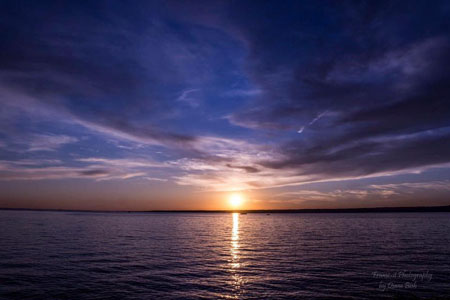
Photo by Diane Bish
Links between Oneida Lake's fertility, its algae and small invertebrates such as zebra mussels, its fish community and bird life, and the human activity affecting the lake have been discussed in this Profile. These links point to complex interactions within the lake's food web. The Oneida Lake food web today reflects a fusion of 10,000 years of natural succession and human-induced changes.
Good fishing and quality fish populations depend on the availability of small organisms. Microscopic creatures, called algae, form the base of the Oneida Lake food web.
Over 120 forms of algae have been identified in the lake, nearly half of which are common or abundant. Macroscopic animals, called zooplankton, eat algae for nutrition.
One common zooplankton, named Daphnia, is not only an excellent algae consumer, but is also a prime food for young yellow perch, gizzard shad, and white perch. Occasionally, these juvenile fish will exhaust the lake's Daphnia supply and thereby trigger increased algae densities. When this occurs, Oneida's water clarity diminishes.
Faced with fewer Daphnia, young yellow and white perch will feed on other zooplankton and invertebrates, while young Zebra gizzard shad will shift their diet to algae. In turn, these baitfish are eaten by yearling and older walleyes. Consequently, growth and survival of walleyes are directly related to the abundance of these small fish. Walleyes begin feeding on young yellow perch in late June and, in years when small perch are scarce, adult walleyes can easily deplete the population by late summer. Walleyes then become cannibalistic and eat their young.
In other years, when yellow perch and gizzard shad are abundant in late summer and fall, walleyes abandon their cannibalistic traits and the survival of their young increases dramatically. Years of high walleye survival produce what biologists call a good walleye "year class." During times when young yellow perch grow quickly, juvenile walleyes enjoy only a brief period to feed on these fish and must divert their predation to insects. Young walleyes grow slower on this diet and remain vulnerable to adult fish for a longer period. Events like these can greatly impact Oneida Lake's walleye population and have contributed to the high variability in this fish's numbers during the late 1980's and 1990's.
Oneida Lake and Its Environs
Lakes are fragile natural resources that must be treated carefully and wisely. The Oneida Lake ecosystem is in a state of flux. It is important that the public understand Oneida Lake and its changing environment so that sound decisions can be made regarding the lake's future. To reach this goal, we recommend the following actions:
• Actively participate in the Oneida Lake scene. Get involved when important issues are at stake. Join organizations, such as the Oneida Lake Association, that provide a strong political base and stimulus for legislation and programs that protect the lake.
• Support watershed and lake planning efforts. Remember that what happens in Oneida's sensitive watershed will greatly impact the lake and, ultimately, all of Central New York. Watershed and lake shore development should be orderly and compatible with the ecosystem.
• Wetlands are delicate areas, important to the lake's overall excellence. They must remain in their natural state. They filter out pollution, trap sediments, store water during heavy precipitation, and provide habitat for scores of animals and plants. Support all efforts to preserve Oneida Lake's wetlands.

Photo by Scott Shupe
• Oneida Lake's water levels should be kept as they are, both to insure the health of the lake's valuable wetlands and to prevent any environmental damage to the lake's fragile ecosystem. Any efforts to lower the lake's current seasonal levels must be strongly opposed.
• Advocate continued lake and watershed research. Remember--the better we understand how Oneida Lake functions, the more effective we can be in maintaining its high quality.
• Encourage programs that promote public environmental awareness and education.
• Enjoy and appreciate Oneida Lake. Spend as much quality time there as possible. Share the lake with your family and friends. It's one of the finest aquatic resources in the United States.
About This Publication
The Oneida Lake Profile was created by Edward L. Mills, Lars G. Rudstam, Connie Adams, Anthony VanDeValk, and John Forney of the Cornell University Field Station, Milo Richmond and Rebecca Schneider of the Department of Natural Resources at Cornell, and Jack Henke of the Oneida Lake Association. Sincere thanks go to everyone who contributed to this project.
The Profile was funded by Cornell University and by the Oneida Lake Association. The University and the Association encourage you to share this bulletin with others and to spread its message.

